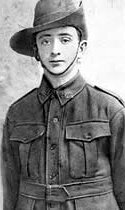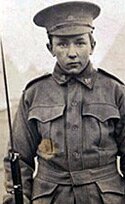As so many others the boy fibbed about his age to join up. When Jim's father was rejected for military service, the 5'6" lad said: "Never mind dad, I'll go instead".
Jim landed with his battalion on Gallipoli on 8 September 1915. He wrote to his family that the Turks are "still about 70 yards away from us", and asked them not to worry about him, "as I am doing splendid over here". But on 25th October he was evacuated to an hospital ship suffering from typhoid fever caught in the trenches. He died of heart failure that evening.
"In those days if you were big enough you were good enough", he recalled later. "They didn't really care about your age."
Alec too fought in Turkey, where his comrades nicknamed him The Kid.
He remembered an "incredible hail of bullets" on landing at Gallipoli, where he was set to work ferrying water in the trenches, sleeping in a "cold, damp hole in the ground".
Six weeks later he was too sick with enteric fever to fight and he was invalided home.
Alec Campbell died in Hobart, Australia, on 16 May 2002.
He was 103 years old.
Determined, John decided to become a humble Private instead. His father then asked a highly placed officer to intervene. So the boy became a Second Lieutenant in the Second Battalion of the Irish Guards. John was still only 17 when he went overseas to France, where he fought at Loos.
When Kipling received a telegram from the War office saying that John was wounded and missing in action, he and his wife made countless journeys to France, searching for news on him. Eventually, they realised their son must indeed be dead.


